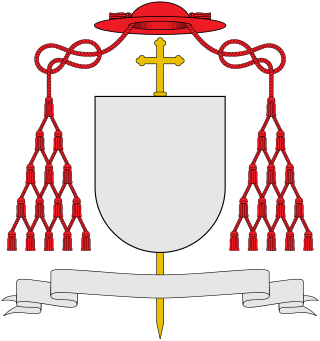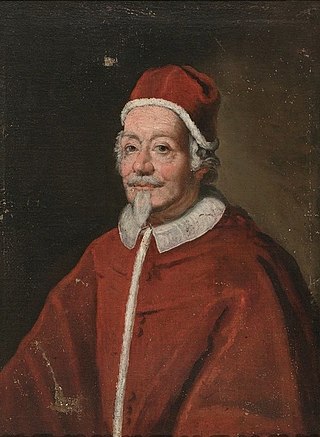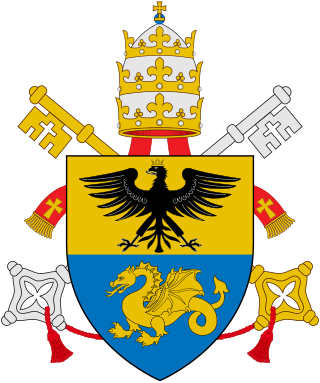This article needs additional citations for verification .(March 2016) |
Gregorio Panzani (died 1662) was an Italian Catholic priest, who became Bishop of Mileto and a papal emissary to England during the reign of King Charles I of England.
This article needs additional citations for verification .(March 2016) |
Gregorio Panzani (died 1662) was an Italian Catholic priest, who became Bishop of Mileto and a papal emissary to England during the reign of King Charles I of England.
Gregorio Panzani received a Doctorate in utroque iure (in both civil law and canon law) at the Archiginnasio di Roma on 7 March 1625. [1] He joined the Congregation of the Oratory, becoming a priest, but, on account of ill-health, he resigned and became a secular priest of the diocese of Arezzo. In 1634 he was chosen by Cardinal Antonio Barberini for the important and delicate task of a secret agency in London. He is described by the writer of his memoirs[ who? ] as a man: [2]
...of experienced virtue, of singular address, of polite learning and in all respects well qualified for the business.
Barberini was keen to gain more information about the progress of Catholics in England and Panzani's commission was to gain first-hand information as to the state of English Catholics. English Catholics were then much divided on the question of the oath of allegiance and the appointment of a vicar Apostolic and moves were afoot to settle the differences that had arisen on these points between the seculars and regulars and to establish informal relations between Barberini's uncle Pope Urban VIII and the Government.
Panzani himself realized that the appointment of a bishop was necessary, and he resented the efforts of the Jesuits to hinder this. Though he was successful in reconciling seculars with the Benedictines and other Catholics, the Jesuits were left out of the settlement, and Panzani's subsequent efforts to bring them in were fruitless.
Panzani had repeated interviews with Windebank and Lord Cottington, the secretaries of state, enjoyed (like Rossetti) the confidence of the Queen, Henrietta Maria, and was admitted to secret audience with King Charles. He was also in communication with Richard Montagu, the Anglican Bishop of Chichester on the subject of corporate reunion.
He was recalled at the end of the year 1636 when a scheme of reciprocal agency[ further explanation needed ] was established between Pope Urban VIII and the Queen. Returning to Rome he was made a canon of S. Lorenzo in Damaso, and obtained a judicial position in the civil courts. On 13 August 1640, he was elected Bishop of Mileto, in the Province of Catanzaro. [3]
An account of his English mission was written in Italian by someone who had access to his papers, and a copy of this was used by Charles Dodd, who, however, thought it imprudent to publish these memoirs in full. But in 1793, Joseph Berington published a translation of them with an historical introduction and supplement. Their authenticity was immediately called in question by Charles Plowden, who regarded them as a forgery by Dodd. The subsequent researches by M. A. Tierney,[ citation needed ] however, conclusively proved[ how? ] that the Memoirs were genuine. The original manuscript, then in the possession of Cardinal Filippo Antonio Gualterio, was purchased by the British Museum in 1854 (Add. Manuscripts 15389).

A cardinal is a senior member of the clergy of the Catholic Church. Cardinals are created by the pope and typically hold the title for life. Collectively, they constitute the College of Cardinals. The most solemn responsibility of the cardinals is to elect a new pope in a conclave, almost always from among themselves, when the Holy See is vacant. During the period between a pope's death or resignation and the election of his successor, the day-to-day governance of the Holy See is in the hands of the College of Cardinals. The right to participate in a conclave is limited to cardinals who have not reached the age of 80 years by the day the vacancy occurs. In addition, cardinals collectively participate in papal consistories, in which matters of importance to the Church are considered and new cardinals may be created. Cardinals of working age are also appointed to roles overseeing dicasteries of the Roman Curia, the central administration of the Catholic Church.

Pope Alexander VIII, born Pietro Vito Ottoboni, was head of the Catholic Church and ruler of the Papal States from 6 October 1689 to his death in February 1691.

Pope Urban VIII, born Maffeo Vincenzo Barberini, was head of the Catholic Church and ruler of the Papal States from 6 August 1623 to his death, in July 1644. As pope, he expanded the papal territory by force of arms and advantageous politicking, and was also a prominent patron of the arts, commissioning works from artists like Bernini and a reformer of Church missions. His papacy also covered 21 years of the Thirty Years' War.

Pope Leo XI, born Alessandro Ottaviano de' Medici, was head of the Catholic Church and ruler of the Papal States from 1 April 1605 to his death, on 27 April 1605. His pontificate is one of the briefest in history, having lasted under a month. He was from the prominent House of Medici originating from Florence. Medici's mother opposed his entering the priesthood and sought to prevent it by having him given secular honours, but after her death he eventually was ordained a priest in 1567. In his career he served as Florence's ambassador to the pope, Bishop of Pistoia, Archbishop of Florence, Papal legate to France, and as the cardinal Prefect for the Congregation of Bishops and Regulars. He was elected to the papacy in the March 1605 papal conclave and served as pope for 27 days.

Pope Paul V, born Camillo Borghese, was head of the Catholic Church and ruler of the Papal States from 16 May 1605 to his death, in January 1621. In 1611, he honored Galileo Galilei as a member of the papal Accademia dei Lincei and supported his discoveries. In 1616, Pope Paul V instructed Cardinal Robert Bellarmine to inform Galileo that the Copernican theory could not be taught as fact, but Bellarmine's certificate allowed Galileo to continue his studies in search for evidence and use the geocentric model as a theoretical device. That same year Paul V assured Galileo that he was safe from persecution so long as he, the Pope, should live. Bellarmine's certificate was used by Galileo for his defense at the trial of 1633.

Charles Borromeo was the Archbishop of Milan from 1564 to 1584 and a cardinal of the Catholic Church. He was a leading figure of the Counter-Reformation combat against the Protestant Reformation together with Ignatius of Loyola and Philip Neri. In that role he was responsible for significant reforms in the Catholic Church, including the founding of seminaries for the education of priests. He is honoured as a saint by the Catholic Church, with a feast day on 4 November.
The Pontifical Scots College in Rome is the main seminary for the training of men for the priesthood from the dioceses of the Roman Catholic Church in Scotland. It was established by a bull of Pope Clement VIII on 5 December 1600.

The Pontifical Urban University, also called the Urbaniana after its names in both Latin and Italian, is a pontifical university that was under the authority of the Congregation for the Evangelization of Peoples. The university's mission is to train priests, religious brothers and sisters, and lay people for service as missionaries. Its campus is located on the Janiculum Hill in Rome, on extraterritorial property of the Holy See.
The Archpriest Controversy was the debate which followed the appointment of an archpriest by Pope Clement VIII to oversee the efforts of the Roman Catholic Church's missionary priests in England at the end of the sixteenth century.

The Diocese of Mileto-Nicotera-Tropea is a Latin diocese of the Catholic Church in Calabria, southern Italy, created in 1986. In that year the historical Diocese of Mileto was united with the Diocese of Nicotera-Tropea. The diocese is a suffragan of the Archdiocese of Reggio Calabria-Bova.
Morys Clynnog, also known as Maurice Clen(n)ock(e), was a Welsh Roman Catholic priest and recusant exile. He was the first head of the English College, Rome. He was born at Llŷn or Eifionydd circa 1525 and died at sea in 1581.

Francesco Maria Brancaccio was an Italian Catholic cardinal.
Henry Holden was an English Roman Catholic priest, known as a theologian.
Orazio Giustiniani was an Italian Catholic Cardinal.

Giulio Cesare Sacchetti was an Italian Catholic cardinal and was twice included in the French Court's list of acceptable candidates for the Papacy, in 1644 and 1655.

Carlo Rossetti (Roscetti) (1614 – 23 November 1681) was an Italian Catholic Cardinal, born of the noble Rossetti family in Ferrara. Earlier in his career he went to London as a secret nuncio on behalf of Pope Urban VIII. While in London, he was addressed as Lord Charles Rossetti and was referred to as Prince Rossetti, using his title as Italian nobility for his cover, rather than as a representative of the Roman Catholic Church to avoid persecution.
George Conn was a Scottish Roman Catholic priest, a Franciscan and papal diplomat in England.

Marcantonio Barbarigo was an Italian cardinal of the Roman Catholic Church. He was the founder of the Pontifical Institute of the Religious Teachers Filippini and also founded both the Religious Teachers Filippini of Montefiascone and the Augustinian Sisters of Divine Love. He was the great-uncle of Pope Clement XIII and was a relative of Gregorio Barbarigo.
Pietro Antonio Spinelli was a Roman Catholic prelate who served as Archbishop of Rossano (1629–1645).
Didier Palleti, C.R.L. (1587–1658) was a Roman Catholic prelate who served as Bishop of Nice (1644–1658).
![]() This article incorporates text from a publication now in the public domain : Herbermann, Charles, ed. (1913). "Gregorio Panzani". Catholic Encyclopedia . New York: Robert Appleton Company.
This article incorporates text from a publication now in the public domain : Herbermann, Charles, ed. (1913). "Gregorio Panzani". Catholic Encyclopedia . New York: Robert Appleton Company.